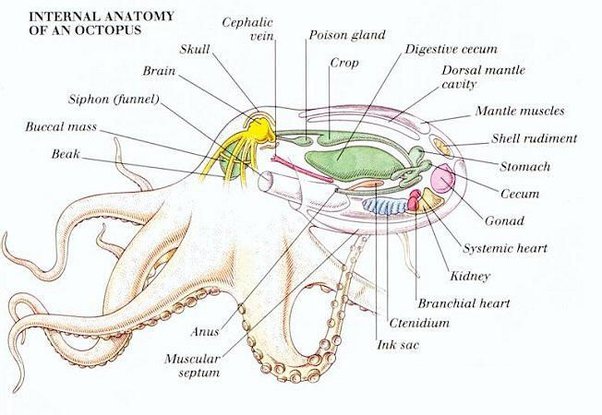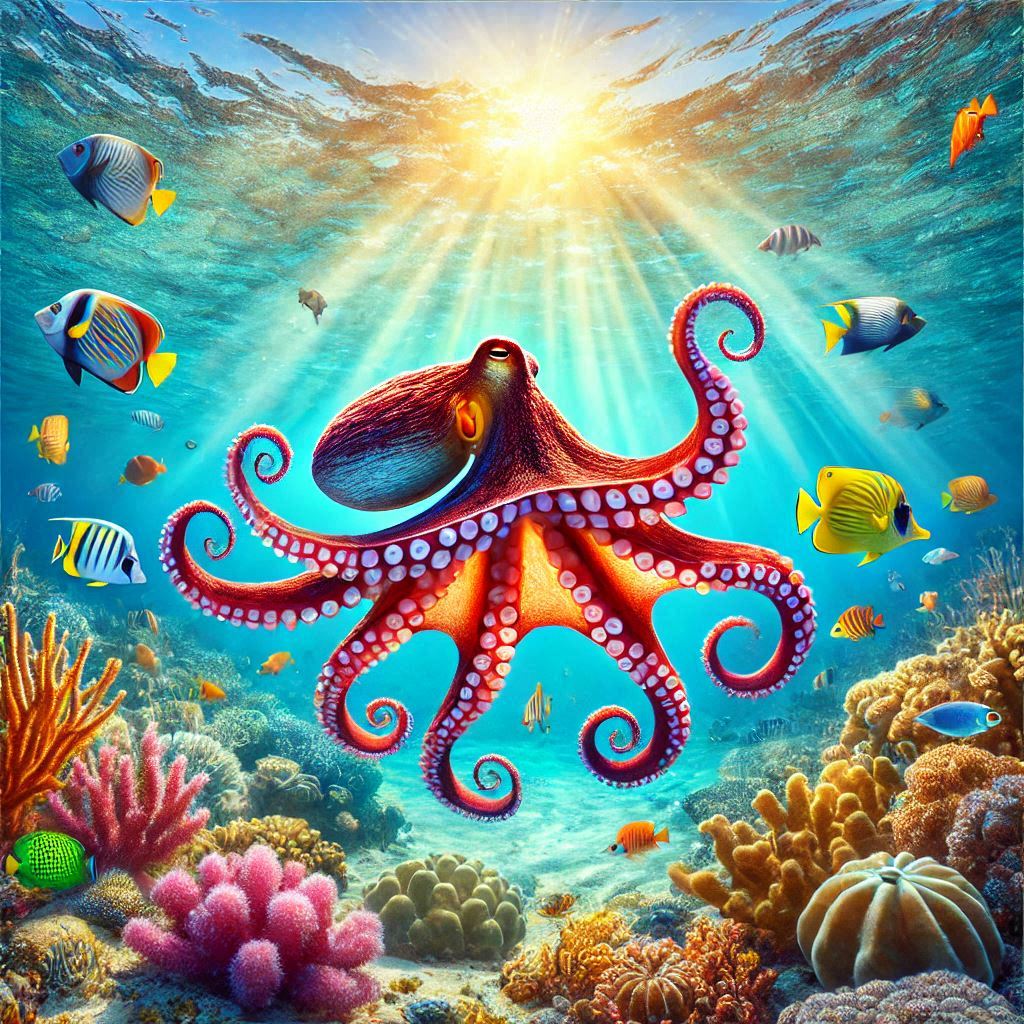Introduction
The ocean is home to some of the most mysterious and awe-inspiring creatures, but few captivate our imagination quite like the octopus. Known for their intelligence, camouflage abilities, and otherworldly appearance, octopuses are nothing short of remarkable. One of their most intriguing features is their unique circulatory system, which includes not one but multiple hearts. But how many hearts does an octopus have, and why do they need so many? Let’s dive into the fascinating biology of this enigmatic sea creature.

How Many Hearts Does an Octopus Have ?
The ocean is home to some of the most mysterious and awe-inspiring creatures, but few captivate our imagination quite like the octopus. Known for their intelligence, camouflage abilities, and otherworldly appearance, octopuses are nothing short of remarkable. Among the many features that set them apart from other marine animals, their circulatory system stands out as a true marvel. Unlike humans and most other creatures, octopuses do not rely on a single heart to pump blood through their bodies. Instead, they possess not one, not two, but three hearts—a feature that is both fascinating and essential to their survival.
So, how many hearts does an octopus have? The answer is three. But simply stating the number doesn’t do justice to the intricacy and elegance of this biological system. Each of these three hearts plays a crucial role in ensuring the octopus’s survival in its aquatic environment. Let’s dive deeper into how these hearts work together.

Two of the three hearts are called branchial hearts. These hearts are located near the gills and are responsible for pumping deoxygenated blood to the gills. At the gills, the blood undergoes oxygenation—a process where oxygen from the surrounding water diffuses into the blood, and carbon dioxide is expelled. This step is vital for the octopus to meet its oxygen requirements, as water contains significantly less oxygen than air.
Once the blood is oxygenated, it is transferred to the third heart, known as the systemic heart. This central heart takes over the job of pumping oxygen-rich blood to the rest of the octopus’s body. It ensures that all the tissues and organs receive the oxygen and nutrients they need to function effectively. This distribution system supports the octopus’s highly active lifestyle, which includes hunting prey, escaping predators, and exploring its environment.
However, the functionality of the systemic heart has an interesting quirk: it temporarily stops beating when the octopus swims. Why does this happen? Swimming is an energy-intensive activity that requires the octopus to conserve resources. By halting the systemic heart, the octopus reduces the flow of oxygenated blood to its body, directing energy toward its propulsion instead. While this might seem like a risky trade-off, the octopus compensates by relying on its branchial hearts to keep oxygenating blood during these moments.
Another unique feature of the octopus’s circulatory system is its blue blood. Unlike humans, whose blood appears red due to iron-based hemoglobin, octopuses have copper-based hemocyanin. This molecule is especially efficient at transporting oxygen in cold and low-oxygen environments, making it ideal for the octopus’s underwater habitat. Hemocyanin not only gives their blood its distinctive blue color but also enhances their ability to survive in extreme conditions, from shallow reefs to deep-sea trenches.
The evolutionary adaptation of having three hearts is crucial for the octopus’s survival. It enables them to meet the high oxygen demands of their active lifestyle while thriving in environments where oxygen availability can vary widely. This tri-heart system is a perfect example of nature’s ingenuity, highlighting how specialized and efficient marine creatures can be.
Understanding how these three hearts function not only deepens our appreciation for octopuses but also underscores the complexity of life in the ocean. The octopus’s circulatory system is a masterpiece of evolution, ensuring that these intelligent and versatile creatures remain one of the ocean’s most fascinating inhabitants.
Why Does an Octopus Need Three Hearts?
The answer lies in the octopus’s unique anatomy and lifestyle. Unlike terrestrial animals, octopuses live in water, where oxygen levels are lower. To thrive in such an environment, they need an efficient circulatory system to maximize oxygen intake and distribution. Here’s why three hearts are essential:
High Oxygen Demand: – Octopuses are active predators that rely on bursts of speed and strength to capture prey. This high level of activity requires a continuous supply of oxygen.
Separate Functions: By having two branchial hearts dedicated to oxygenating blood and one systemic heart for distribution, the octopus’s circulatory system ensures optimal oxygen usage.
Adaptability: When an octopus swims, its systemic heart temporarily stops beating, reducing oxygen flow to the body. During these moments, the branchial hearts continue to work, keeping the gills supplied with blood. This adaptation allows octopuses to conserve energy during swimming while ensuring their vital functions remain intact.
The Role of Hemocyanin in Octopus Blood

The efficiency of an octopus’s circulatory system is further enhanced by a special molecule in their blood called hemocyanin. Unlike the hemoglobin in human blood, which gives it a red color, hemocyanin is copper-based, making octopus blood appear blue. Hemocyanin has several advantages:
Better Oxygen Transport: Hemocyanin is more efficient at transporting oxygen in cold and low-oxygen environments, such as the deep sea.
Survival in Extreme Conditions: This molecule allows octopuses to survive in habitats ranging from shallow coastal waters to the deep ocean.
However, the downside is that hemocyanin is less efficient than hemoglobin when oxygen levels are high, which is one reason octopuses tire quickly during prolonged activity.
Octopus Circulation: How It Works
To understand the role of the three hearts, let’s take a closer look at the circulatory process:
Deoxygenated Blood:
- Blood flows from the body to the two branchial hearts.
- These hearts pump it to the gills, where it picks up oxygen.
Oxygenated Blood:
- The now oxygen-rich blood flows to the systemic heart.
- The systemic heart pumps it to the rest of the body, delivering oxygen and nutrients to tissues and organs.
Temporary Heart Pause:
- During swimming, the systemic heart pauses, reducing oxygen supply to the body. This trade-off allows more energy to be focused on propulsion and movement.
What Happens When an Octopus Loses a Heart?
While an octopus’s three-heart system is incredibly efficient, it also means that losing one heart can severely impact its survival. For instance:
- If the systemic heart fails, the octopus cannot deliver oxygen to its body effectively, leading to reduced mobility and eventual death.
- Damage to one or both branchial hearts compromises oxygenation, making it difficult for the octopus to breathe.
Fortunately, octopuses are known for their regenerative abilities and can sometimes recover from injuries that affect their circulatory system.

Comparisons with Other Animals
The octopus’s three-heart system may seem extraordinary, but it’s not entirely unique in the animal kingdom. Here are some comparisons:
Earthworms: Earthworms have five pseudo-hearts, which are actually aortic arches that help circulate blood.
Cephalopod Relatives: Other cephalopods, such as squids and cuttlefish, also have three hearts and a similar circulatory system.
Human Circulatory System: Humans have a single heart with four chambers, which efficiently pumps blood through a closed circulatory system. While humans rely on one heart to perform all circulatory functions, the octopus’s division of labor among three hearts is a fascinating example of evolutionary specialization.
The Evolutionary Advantage of Three Hearts
The octopus’s three hearts are a result of millions of years of evolution. This adaptation has allowed them to:
Explore Diverse Habitats: From shallow coral reefs to deep-sea trenches, the octopus’s circulatory system supports its survival in a wide range of environments.
Efficient Predation: Their active hunting lifestyle, which includes ambushing prey and escaping predators, demands a highly efficient oxygen delivery system.
Energy Conservation: The ability to pause the systemic heart during swimming helps conserve energy, a crucial survival strategy in resource-scarce environments.
Fun Facts About Octopus Hearts
Colorful Blood: The blue blood of octopuses is a result of hemocyanin, making their circulatory system as unique as their hearts.
Swimming Trade-Off: When octopuses swim, their systemic heart pauses, which is why they prefer crawling along the seafloor rather than swimming for extended periods.
Regenerative Abilities: In addition to their circulatory marvels, octopuses can regrow lost limbs, showcasing their incredible resilience.
Conservation and the Importance of Octopuses
Understanding the biology of octopuses is not just fascinating but also crucial for their conservation. These creatures play a vital role in marine ecosystems, acting as both predators and prey. However, they face threats from overfishing, habitat destruction, and climate change. Protecting octopuses and their habitats ensures the health of marine ecosystems and preserves these remarkable creatures for future generations.
Conclusion
The octopus’s three hearts are a testament to the wonders of evolution and adaptation. These hearts work in harmony to sustain a creature that is as mysterious as it is intelligent. From their blue blood to their ability to pause a heart during swimming, every aspect of the octopus’s circulatory system is designed for survival in the challenging underwater world.
Next time you marvel at an octopus in an aquarium or see one in the wild, remember the incredible biology working behind the scenes. Their three hearts are not just a quirky feature but a key to their success as one of the ocean’s most captivating inhabitants.
References
- National Geographic – Octopus Facts
Link: https://www.nationalgeographic.com/animals/invertebrates/facts/octopus
Description: Detailed information about octopus biology, including their hearts, circulatory system, and unique adaptations. - Smithsonian Ocean – The Octopus
Link: https://ocean.si.edu/ocean-life/invertebrates/octopus
Description: Insights into octopus anatomy, behaviors, and survival mechanisms. - MBARI (Monterey Bay Aquarium Research Institute) – Octopus Adaptations
Link: https://www.mbari.org
Description: Scientific exploration of octopus adaptations to deep-sea environments, including their circulatory system. - Live Science – Why Octopus Blood is Blue
Link: https://www.livescience.com/why-octopus-blood-is-blue
Description: Explains the role of hemocyanin in the octopus circulatory system and its evolutionary importance. - Journal of Experimental Biology – Octopus Circulation and Physiology
Link: https://journals.biologists.com/jeb/article/207/12/1953/14044/Functional-aspects-of-circulation-in-the-octopus
Description: A research article detailing the functional aspects of octopus circulation. - The Guardian – Octopus Intelligence and Biology
Link: https://www.theguardian.com/science/2020/jan/27/octopus-intelligence-amazing-abilities
Description: Covers the intelligence, anatomy, and unique biology of octopuses, including their three hearts.
Discover more from ZOOLOGYTALKS
Subscribe to get the latest posts sent to your email.


Pingback: PHYLUM MOLLUSCA - Characteristics and Classification | ZOOLOGYTALKS | 2024